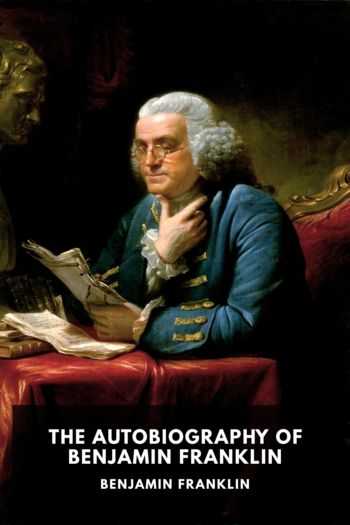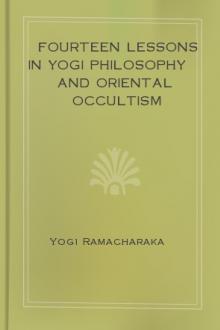Autobiography of a Yogi by Paramahansa Yogananda (self help books to read txt) 📕

- Author: Paramahansa Yogananda
- Performer: 978-0876120835
Book online «Autobiography of a Yogi by Paramahansa Yogananda (self help books to read txt) 📕». Author Paramahansa Yogananda
Americans may well remember with pride the successful nonviolent experiment of William Penn in founding his 17th century colony in Pennsylvania. There were “no forts, no soldiers, no militia, even no arms.” Amidst the savage frontier wars and the butcheries that went on between the new settlers and the Red Indians, the Quakers of Pennsylvania alone remained unmolested. “Others were slain; others were massacred; but they were safe. Not a Quaker woman suffered assault; not a Quaker child was slain, not a Quaker man was tortured.” When the Quakers were finally forced to give up the government of the state, “war broke out, and some Pennsylvanians were killed. But only three Quakers were killed, three who had so far fallen from their faith as to carry weapons of defence.”
“Resort to force in the Great War (I) failed to bring tranquillity,” Franklin D. Roosevelt has pointed out. “Victory and defeat were alike sterile. That lesson the world should have learned.”
“The more weapons of violence, the more misery to mankind,” Lao-tzu taught. “The triumph of violence ends in a festival of mourning.”
“I am fighting for nothing less than world peace,” Gandhi has declared. “If the Indian movement is carried to success on a nonviolent SATYAGRAHA basis, it will give a new meaning to patriotism and, if I may say so in all humility, to life itself.”
Before the West dismisses Gandhi’s program as one of an impractical dreamer, let it first reflect on a definition of SATYAGRAHA by the Master of Galilee:
“Ye have heard that it hath been said, An eye for an eye, and a tooth for a tooth: but I say unto you, That ye resist not evil: {FN44-20} but whosoever shall smite thee on thy right cheek, turn to him the other also.”
Gandhi’s epoch has extended, with the beautiful precision of cosmic timing, into a century already desolated and devastated by two World Wars. A divine handwriting appears on the granite wall of his life: a warning against the further shedding of blood among brothers.
MAHATMA GANDHI’S HANDWRITING IN HINDI
[Illustration—see gandhi2.jpg]
Mahatma Gandhi visited my high school with yoga training at Ranchi. He graciously wrote the above lines in the Ranchi guest-book. The translation is: “This institution has deeply impressed my mind. I cherish high hopes that this school will encourage the further practical use of the spinning wheel.”
(SIGNED) MOHANDAS GANDHI September 17, 1925
[Illustration—see gandhiflag.jpg]
A national flag for India was designed in 1921 by Gandhi. The stripes are saffron, white and green; the CHARKA (spinning wheel) in the center is dark blue. “The CHARKA symbolizes energy,” he wrote, “and reminds us that during the past eras of prosperity in India’s history, hand spinning and other domestic crafts were prominent.”
{FN44-1} His family name is Mohandas Karamchand Gandhi. He never refers to himself as “Mahatma.”
{FN44-2} The literal translation from Sanskrit is “holding to truth.” SATYAGRAHA is the famous nonviolence movement led by Gandhi.
{FN44-3} False and alas! malicious reports were recently circulated that Miss Slade has severed all her ties with Gandhi and forsaken her vows. Miss Slade, the Mahatma’s SATYAGRAHA disciple for twenty years, issued a signed statement to the UNITED PRESS, dated Dec. 29, 1945, in which she explained that a series of baseless rumors arose after she had departed, with Gandhi’s blessings, for a small site in northeastern India near the Himalayas, for the purpose of founding there her now-flourishing KISAN ASHRAM (center for medical and agricultural aid to peasant farmers). Mahatma Gandhi plans to visit the new ashram during 1946.
{FN44-4} Miss Slade reminded me of another distinguished Western woman, Miss Margaret Woodrow Wilson, eldest daughter of America’s great president. I met her in New York; she was intensely interested in India. Later she went to Pondicherry, where she spent the last five years of her life, happily pursuing a path of discipline at the feet of Sri Aurobindo Ghosh. This sage never speaks; he silently greets his disciples on three annual occasions only.
{FN44-5} For years in America I had been observing periods of silence, to the consternation of callers and secretaries.
{FN44-6} Harmlessness; nonviolence; the foundation rock of Gandhi’s creed. He was born into a family of strict Jains, who revere AHIMSA as the root-virtue. Jainism, a sect of Hinduism, was founded in the 6th century B.C. by Mahavira, a contemporary of Buddha. Mahavira means “great hero”; may he look down the centuries on his heroic son Gandhi!
{FN44-7} Hindi is the lingua franca for the whole of India. An Indo-Aryan language based largely on Sanskrit roots, Hindi is the chief vernacular of northern India. The main dialect of Western Hindi is Hindustani, written both in the DEVANAGARI (Sanskrit) characters and in Arabic characters. Its subdialect, Urdu, is spoken by Moslems.
{FN44-8} Gandhi has described his life with a devastating candor in THE STORY OF MY EXPERIMENTS WITH TRUTH (Ahmedabad: Navajivan Press, 1927-29, 2 vol.) This autobiography has been summarized in MAHATMA GANDHI, HIS OWN STORY, edited by C. F. Andrews, with an introduction by John Haynes Holmes (New York: Macmillan Co., 1930).
Many autobiographies replete with famous names and colorful events are almost completely silent on any phase of inner analysis or development. One lays down each of these books with a certain dissatisfaction, as though saying: “Here is a man who knew many notable persons, but who never knew himself.” This reaction is impossible with Gandhi’s autobiography; he exposes his faults and subterfuges with an impersonal devotion to truth rare in annals of any age.
{FN44-9} Kasturabai Gandhi died in imprisonment at Poona on February 22, 1944. The usually unemotional Gandhi wept silently. Shortly after her admirers had suggested a Memorial Fund in her honor, 125 lacs of rupees (nearly four million dollars) poured in from all over India. Gandhi has arranged that the fund be used for village welfare work among women and children. He reports his activities in his English weekly, HARIJAN.
{FN44-10} I sent a shipment to Wardha, soon after my return to America. The plants, alas! died on the way, unable to withstand the rigors of the long ocean transportation.
{FN44-11} Thoreau, Ruskin, and Mazzini are three other Western writers whose sociological views Gandhi has studied carefully.
{FN44-12} The sacred scripture given to Persia about 1000 B.C. by Zoroaster.
{FN44-13} The unique feature of Hinduism among the world religions is that it derives not from a single great founder but from the impersonal Vedic scriptures. Hinduism thus gives scope for worshipful incorporation into its fold of prophets of all ages and all lands. The Vedic scriptures regulate not only devotional practices but all important social customs, in an effort to bring man’s every action into harmony with divine law.
{FN44-14} A comprehensive Sanskrit word for law; conformity to law or natural righteousness; duty as inherent in the circumstances in which a man finds himself at any given time. The scriptures define DHARMA as “the natural universal laws whose observance enables man to save himself from degradation and suffering.”
{FN44-15} MATTHEW 7:21.
{FN44-16} MATTHEW 26:52.
{FN44-17} “Let not a man glory in this, that he love his country; Let him rather glory in this, that he love his kind.”-PERSIAN PROVERB.
{FN44-18} “Then came Peter to him and said, Lord, how oft shall my brother sin against me, and I forgive him? till seven times? Jesus saith unto him, I say not unto thee, Until seven times: but, Until seventy times seven.”-MATTHEW 18:21-22.
{FN44-19} Charles P. Steinmetz, the great electrical engineer, was once asked by Mr. Roger W. Babson: “What line of research will see the greatest development during the next fifty years?” “I think the greatest discovery will be made along spiritual lines,” Steinmetz replied. “Here is a force which history clearly teaches has been the greatest power in the development of men. Yet we have merely been playing with it and have never seriously studied it as we have the physical forces. Someday people will learn that material things do not bring happiness and are of little use in making men and women creative and powerful. Then the scientists of the world will turn their laboratories over to the study of God and prayer and the spiritual forces which as yet have hardly been scratched. When this day comes, the world will see more advancement in one generation than it has seen in the past four.”
{FN44-20} That is, resist not evil with evil. (MATTHEW 5:38-39)
CHAPTER: 45
THE BENGALI “JOY-PERMEATED” MOTHER
“Sir, please do not leave India without a glimpse of Nirmala Devi. Her sanctity is intense; she is known far and wide as Ananda Moyi Ma (Joy-Permeated Mother).” My niece, Amiyo Bose, gazed at me earnestly.
“Of course! I want very much to see the woman saint.” I added, “I have read of her advanced state of God-realization. A little article about her appeared years ago in EAST-WEST.”
“I have met her,” Amiyo went on. “She recently visited my own little town of Jamshedpur. At the entreaty of a disciple, Ananda Moyi Ma went to the home of a dying man. She stood by his bedside; as her hand touched his forehead, his death-rattle ceased. The disease vanished at once; to the man’s glad astonishment, he was well.”
A few days later I heard that the Blissful Mother was staying at the home of a disciple in the Bhowanipur section of Calcutta. Mr. Wright and I set out immediately from my father’s Calcutta home. As the Ford neared the Bhowanipur house, my companion and I observed an unusual street scene.
Ananda Moyi Ma was standing in an open-topped automobile, blessing a throng of about one hundred disciples. She was evidently on the point of departure. Mr. Wright parked the Ford some distance away, and accompanied me on foot toward the quiet assemblage. The woman saint glanced in our direction; she alit from her car and walked toward us.
“Father, you have come!” With these fervent words she put her arm around my neck and her head on my shoulder. Mr. Wright, to whom I had just remarked that I did not know the saint, was hugely enjoying this extraordinary demonstration of welcome. The eyes of the one hundred chelas were also fixed with some surprise on the affectionate tableau.
I had instantly seen that the saint was in a high state of SAMADHI. Utterly oblivious to her outward garb as a woman, she knew herself as the changeless soul; from that plane she was joyously greeting another devotee of God. She led me by the hand into her automobile.
“Ananda Moyi Ma, I am delaying your journey!” I protested.
“Father, I am meeting you for the first time in this life, after ages!” she said. “Please do not leave yet.”
We sat together in the rear seats of the car. The Blissful Mother soon entered the immobile ecstatic state. Her beautiful eyes glanced heavenward and, half-opened, became stilled, gazing into the near-far inner Elysium. The disciples chanted gently: “Victory to Mother Divine!”
I had found many men of God-realization in India, but never before had I met such an exalted woman saint. Her gentle face was burnished with the ineffable joy that had given her the name of Blissful Mother. Long black tresses lay loosely behind her unveiled head. A red dot of sandalwood paste on her forehead symbolized the spiritual eye, ever open within her. Tiny face, tiny hands, tiny feet-a contrast to her spiritual magnitude!
I put some questions to a near-by woman chela while Ananda Moyi Ma remained entranced.
“The Blissful Mother travels widely in India; in many parts she has hundreds of disciples,” the chela told me. “Her courageous efforts have brought about many desirable social reforms. Although a Brahmin,





Comments (0)